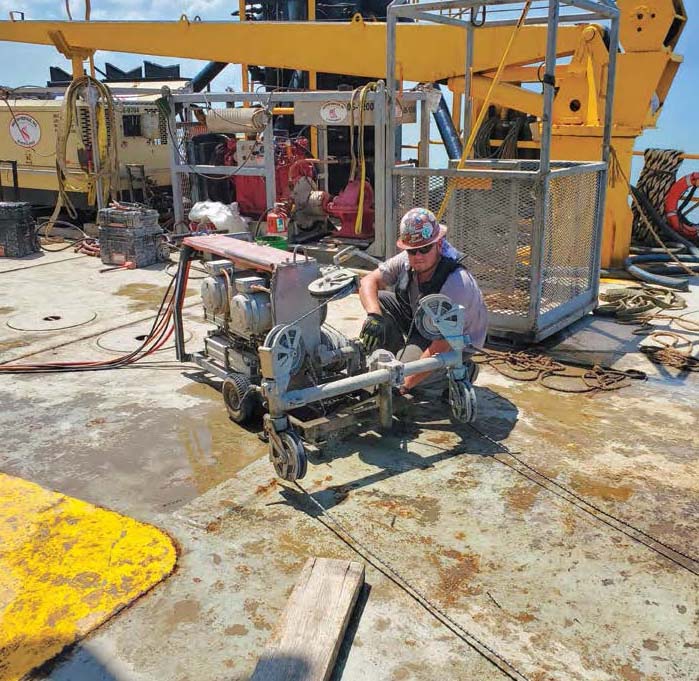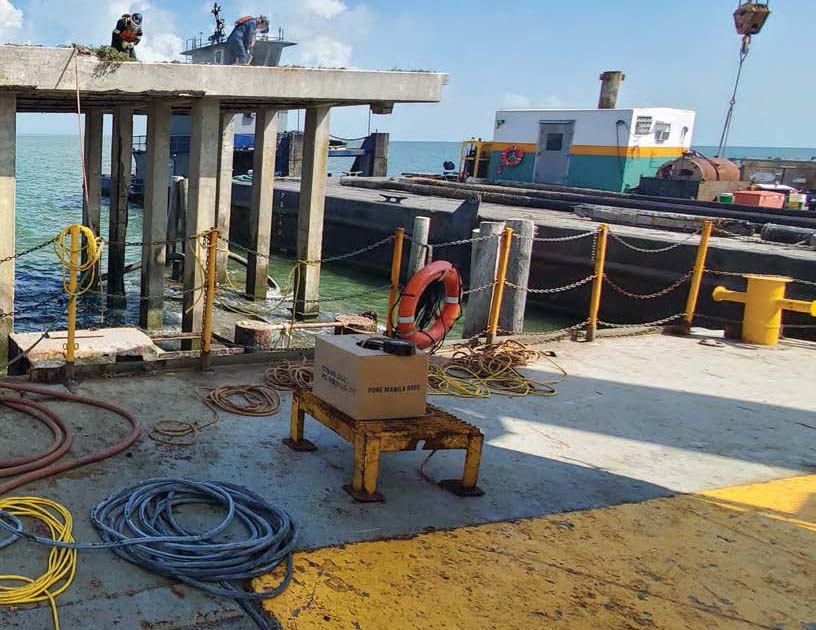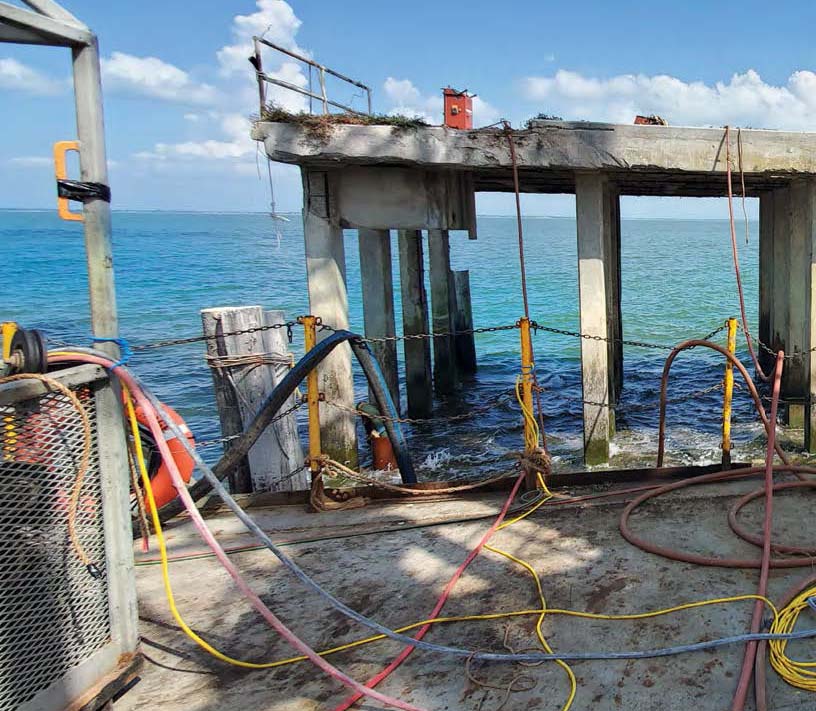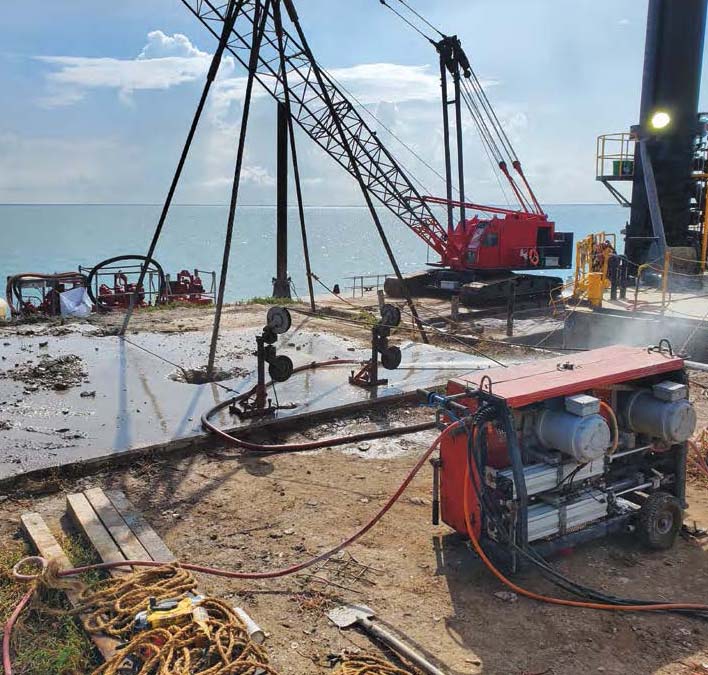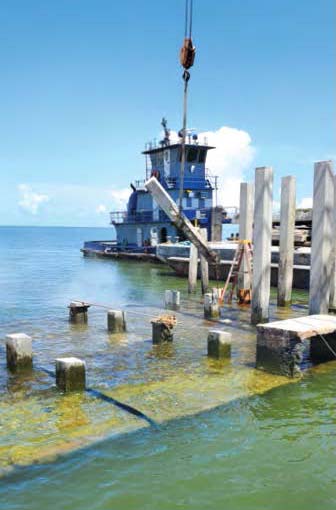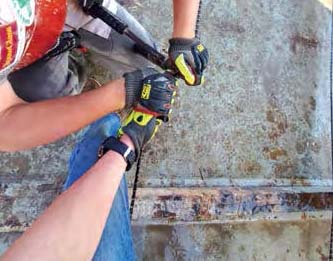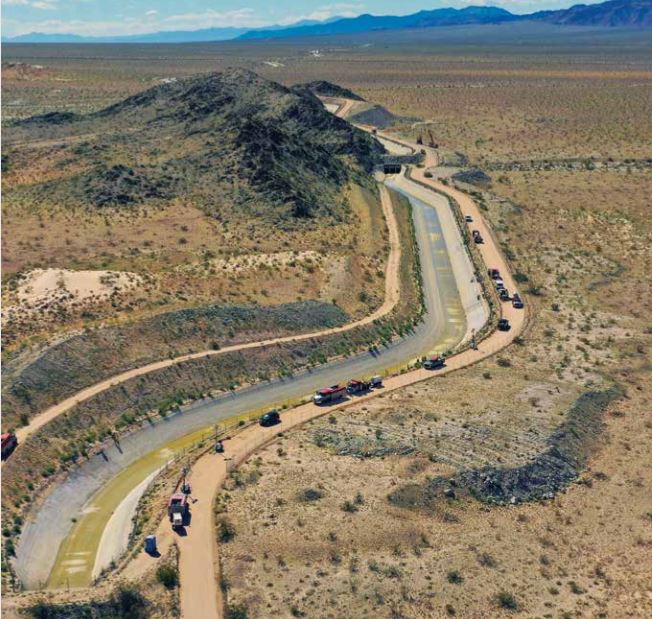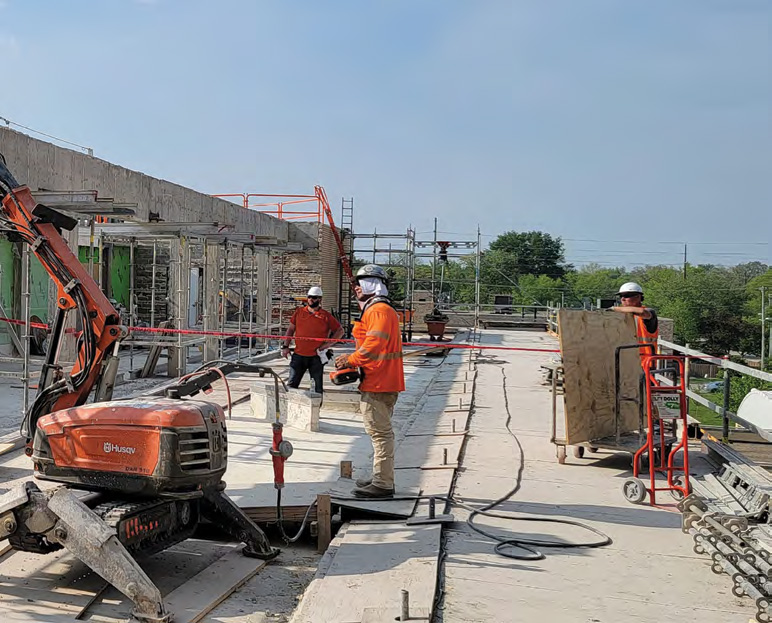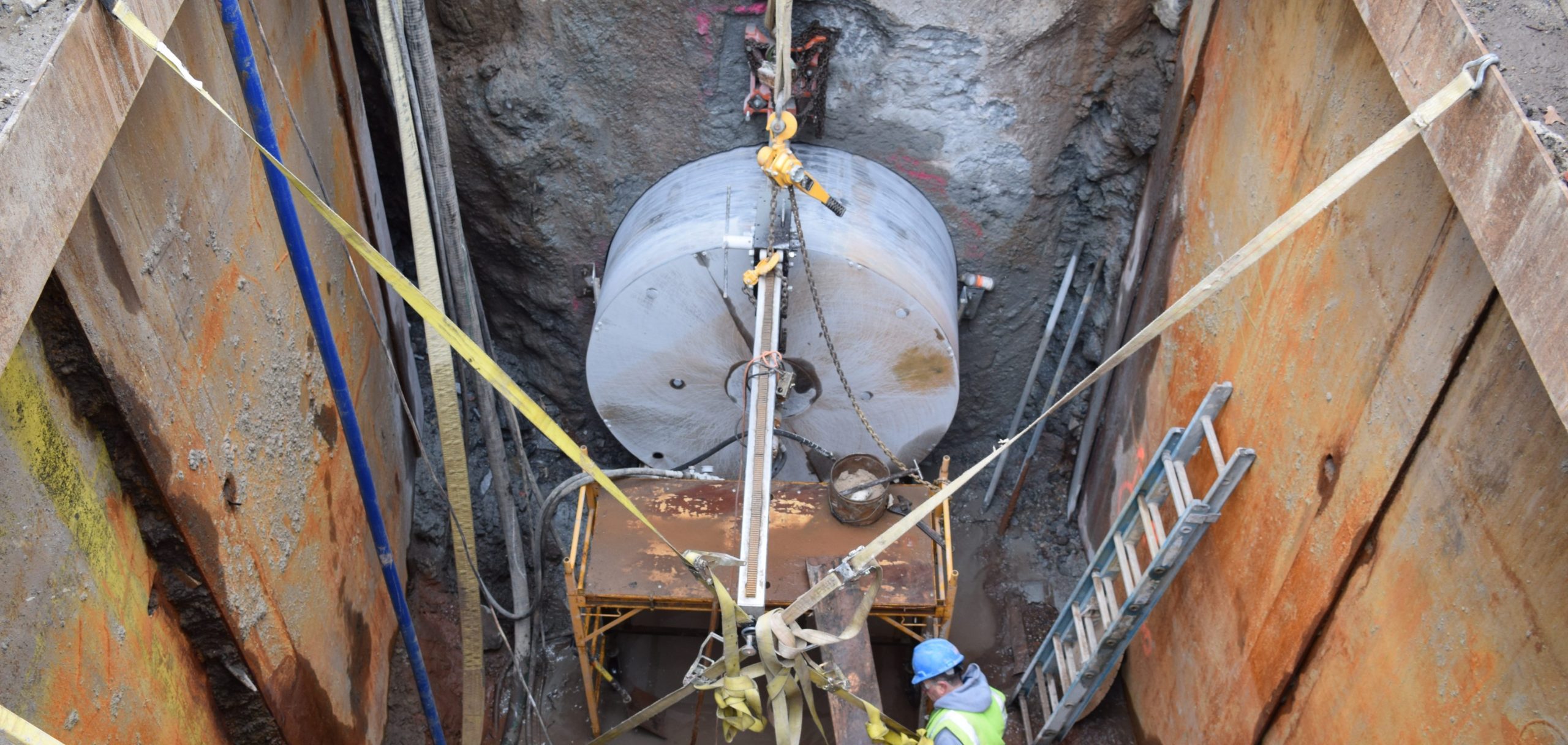
Trinity Bay: Cutting & Removal of a Decommissioned Gas Platform
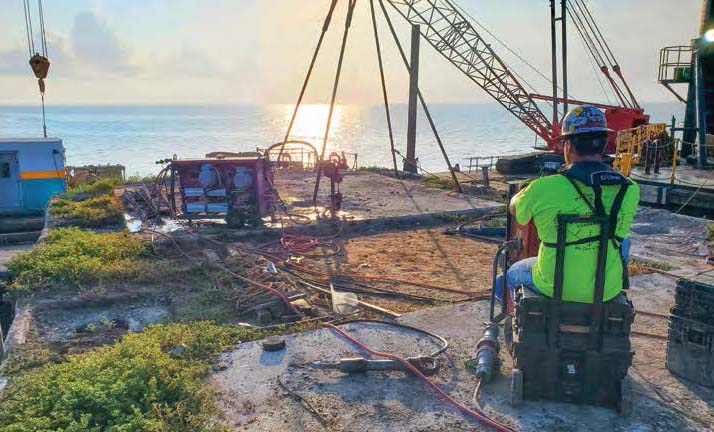
Trinity Bay is about 25 nautical miles east of Houston and 30 nautical miles north of Galveston, located on the southeastern coast of Texas. The 20-mile-wide bay is part of the expansive and vital Houston Ship Channel and its various ports, collectively known as the Port of Houston. It is one of the busiest seaports in the world facilitating the movement of more than 247 million tons of cargo a year and was named the number one port in the United States in 2020 by volume of foreign waterborne tonnage moved and vessel traffic. As the port grows in need, Houston works on continuously improving the channel, expanding it, and making sure it is deep and wide enough to accommodate the traffic.
A decommissioned concrete barge oil platform decaying in Trinity Bay posed a potential issue for the traffic of the Houston Ship Channel. Laredo Construction, Inc., a construction and maintenance company that primarily provides offshore services in the Gulf of Mexico, contacted CSDA member Holes Incorporated for some assistance with the removal of this barge. Laredo Construction did not want to risk blocking the Houston Ship Channel by trying to move the barge in one whole piece or have it become an obstacle, so they asked for Holes’ help with cutting the barge into manageable pieces prior to its journey through the channel for deconstruction, demolition and final removal.
Holes Incorporated was hired to cut the second story platform off the barge, as well as the 40 concrete piles that held the second story in place. This would reduce the overall weight and height of the decommissioned barge to ensure it arrived at the Houston Ship Channel in one piece without potentially breaking or crumbling due to its deteriorated condition. The job was called in on a Friday afternoon with the hiring contractor needing the Holes team on the Offshore Support Vessel (OSV) Dularge Lift Boat by Monday. The job also required Maritime insurance coverage, which Holes had to bind prior to mobilization. Working diligently over the weekend, insurance was bound and a contract was signed Monday morning. At that time, Laredo notified the Holes team that prior to mobilization, operators were required to have a negative COVID-19 test. COVID-19 protocols were strict as the operators would be living on the 32-bunk bed OSV Dularge for the next five days with the Laredo Contracting Crew.
Holes mobilized as quickly as possible. Monday evening, Holes sent the wire saw equipment and the 480 Generator needed to power the wire saw on the 4-hour ride to the job site in the middle of Trinity Bay. The equipment had to be transported to the OSV Dularge via the Vessel Triton prior to the operators’ arrival.
As the Holes operators were completing their COVID testing and awaiting their results, the Vessel Triton had to leave the dock and make its journey. Thankfully for the team
and project, Holes Vice President of Operations Patrick Stepanski was able to save the day by personally delivering Holes operators to the OSV Dularge early Tuesday morning, negative tests in hand, by Pat’s center console fishing boat – this was the first time in Holes Inc. history that Pat had to shuttle employees to a job on his personal fishing boat.
Once all the equipment and operators had arrived on the OSV Dularge, the careful deconstruction could begin. For safety reasons, a single Holes operator accessed the concrete barge by crane basket while the lead operator managed operations from the OSV Dularge. A Hilti WS-15 wire saw with DDM Concut 10MM wire was used to perform the cutting. The upper deck of the barge platform was cut into four equal sections that weighed approximately 75,000 pounds each. Since this work was performed over the water in Trinity Bay, Holes operators could not allow any concrete debris to fall into the water. Therefore, the pieces were removed using an API 100-ton crane which was securely attached to each piece prior to cutting and removal. After the upper deck was cut and removed, Holes operators then cut the columns one by one, using the crane to lift them off the platform and place them on another barge that would be brought to shore and unloaded.
In total, 30’ x 50’ of the upper deck platform was wire sawed into equal sections, with each piece ranging from 12” to 18” thick. The weight of the upper deck of concrete alone was 300,000 pounds. Once the upper deck was cut and removed, the Holes operators moved to sawing and removing the 16’ long, 2,800-pound piles, so that the concrete deck could sit flat on the support barge. Upon completion, Holes cut and removed a total of 412,000-pounds of concrete.
Extensive safety measures were taken to ensure everyone’s protection on-site. Bryan Cheek, Holes, Inc.’s 28-year CSDA certified veteran manned the project with a wire saw operator apprentice, Luke Buchanan. Holes operators conducted Toolbox Safety Tip (TST) talks each morning with the crew. The TSTs reviewed hazards such as working over water, slip, trips and falls and the hazards of working alongside a crane. Along with the TSTs, each morning a Job Safety Analysis (JSA) was completed with the crew, hazards were mitigated and daily tasks were performed safely. The OSV Dularge lift legs were tested prior to wire sawing
the platform to ensure the legs could tolerate the load and wouldn’t sink into the mud of the bay. Having the correct pressure of each section being cut free on the 100-ton crane was also crucial to prevent the concrete from moving and pinching the wire. While the limited access to the platform was challenging, being a 4-hour boat delivery away from any needed spare parts made everything even more complicated. The platform was slippery and covered in marine debris which could cause an injury if safety precautions were not taken. Additional PPE such as ANSI Cut Level A5 gloves and Coast Guard-rated life jackets were worn 100 percent of the time on the barge.
Despite the almost impossibly fast turnaround and the rigid prerequisites, the job was not only finished on time, but much earlier than expected and within budget. This was Holes Incorporated’s first time working with Laredo Construction, and despite not knowing what to expect or anything about them, it was an incredibly successful venture. Darlene East, President of Holes Incorporated states, “Holes is called when the job is difficult, when there is a time crunch and when safety cannot be compromised.”
COMPANY PROFILES
The Holes Companies are service companies specializing in concrete slab sawing, core drilling, wall sawing, wire sawing, pile cutting, concrete breaking, lifting, demolition, GPR scanning, load and haul and anchor bolt installation. The Holes Companies primarily work for commercial and industrial contractors, state highway departments and municipalities. Holes Incorporated, Holes Golden Triangle, LLC, Holes South Texas, LLC and Holes Technology, LP have built a solid track record through 49 years of experience, reliability and reputation. They have 52 employees and 28 operators and have been CSDA members since 1976.
General Contractor: Laredo Construction, Inc.
CSDA Contractor: Holes Incorporated
Contact for Story: Kellie Kimball
Email: Kellie@HolesInc.com Tel: 281-469-7070 Website: www.holesinc.com
Methods Used: Wire Sawing











